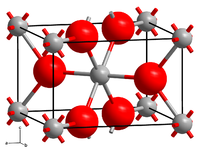Palladium (IV) oxide
| Crystal structure | |||||||||||||
|---|---|---|---|---|---|---|---|---|---|---|---|---|---|

|
|||||||||||||
| __ Pd 4+ __ O 2− | |||||||||||||
| General | |||||||||||||
| Surname | Palladium (IV) oxide | ||||||||||||
| other names |
Palladium dioxide |
||||||||||||
| Ratio formula | PdO 2 | ||||||||||||
| Brief description |
dark red or black solid |
||||||||||||
| External identifiers / databases | |||||||||||||
|
|||||||||||||
| properties | |||||||||||||
| Molar mass | 138.42 g mol −1 | ||||||||||||
| Physical state |
firmly |
||||||||||||
| Melting point |
200 ° C (decomposes to PdO ) |
||||||||||||
| solubility |
insoluble in water, acids and alkalis |
||||||||||||
| safety instructions | |||||||||||||
|
|||||||||||||
| As far as possible and customary, SI units are used. Unless otherwise noted, the data given apply to standard conditions . | |||||||||||||
Palladium (IV) oxide , also known as palladium dioxide , is a chemical compound of the elements palladium and oxygen . The oxide is dark red as a hydrate, while anhydrous is black, and at 200 ° C it breaks down into palladium (II) oxide .
Extraction and presentation
Palladium (IV) oxide is a precipitate when PdCl 6 2− -containing aqueous solutions are mixed with dilute sodium hydroxide :
A solution of sodium carbonate contains sufficient hydroxide ions and can be used instead of sodium hydroxide solution:
Another synthesis method is the anodic oxidation of palladium (II) nitrate . The production by oxidation of palladium (II) chloride with ozone proceeds with poor yields, since the palladium dioxide partially reacts further with the hydrochloric acid obtained as a by-product .
properties
Physical Properties
Palladium dioxide crystallizes in the tetragonal crystal system in the space group P 4 2 / mnm (space group no. 136) with the lattice parameters a = 448 pm and c = 310 pm as well as two formula units per unit cell ( rutile structure ).
Chemical properties
When heated, palladium dioxide gives off oxygen and changes to palladium (II) oxide at 200 ° C, which in turn breaks down into the elements at 875 ° C.
The hydrate dissolves in concentrated sodium hydroxide solution with the formation of hexahydroxopalladate ions, the anhydrous substance is insoluble in alkalis.
The hydrate of palladium dioxide is also soluble in hydrochloric acid, and hexachloropalladate (IV) ions are formed in the process.
Palladium dioxide is initially soluble in oxalic acid , turning yellow and forming dioxalatopalladate (II) ions [Pd (OOC-COO) 2 ] 2− ; when boiled, it is reduced to elemental palladium.
Elemental palladium is also formed when cooking with acetic acid .
Individual evidence
- ↑ a b Palladium (IV) oxide on webelements.com
- ^ A b A. F. Holleman , E. Wiberg , N. Wiberg : Textbook of Inorganic Chemistry . 102nd edition. Walter de Gruyter, Berlin 2007, ISBN 978-3-11-017770-1 , p. 1732.
- ↑ There is not yet a harmonized classification for this substance . A labeling of palladium dioxide in the Classification and Labeling Inventory of the European Chemicals Agency (ECHA), which was retrieved on July 10, 2020, is reproduced from a self-classification by the distributor .
- ↑ a b c d e Lothar Wöhler, James König: "Die Oxyde des Palladiums" in Zeitschr. f. Anorg. Chem. 1905 , 46 , p. 323ff. ( Full text ).
- ↑ IS Shaplygin, GL Aparnikov, VB Lazarev: Preparation of palladium dioxide at high pressure. In: Zhurnal Neorganicheskoi Khimii. 1978, 23, 4, pp. 884-887.
- ^ A b c A. F. Holleman , E. Wiberg , N. Wiberg : Textbook of Inorganic Chemistry . 101st edition. Walter de Gruyter, Berlin 1995, ISBN 3-11-012641-9 , p. 1520.
- ^ MM Vezes: "Sur les sels complexes de palladium: palladoxalate" in Bull. Soc. Chim. 1899 , (3) 21 , pp. 172f. ( Full text ).



![{\ displaystyle \ mathrm {2 \ PdO_ {2} \ \ {\ xrightarrow [{- O_ {2}}] {200 ^ {\ circ} C}} \ \ 2 \ PdO \ \ {\ xrightarrow [{- O_ {2}}] {875 ^ {\ circ} C}} \ \ 2 \ Pd}}](https://wikimedia.org/api/rest_v1/media/math/render/svg/6f47a4ac4d562557185478635bcc68ac755cf721)
![{\ displaystyle \ mathrm {PdO_ {2} +2 \ NaOH + 2 \ H_ {2} O \ longrightarrow Na_ {2} [Pd (OH) _ {6}]}}](https://wikimedia.org/api/rest_v1/media/math/render/svg/7f5e30ec5d42e9c2c20e1fb1ed741ec465ade019)
![{\ displaystyle \ mathrm {PdO_ {2} +6 \ HCl \ longrightarrow H_ {2} [PdCl_ {6}] + 2 \ H_ {2} O}}](https://wikimedia.org/api/rest_v1/media/math/render/svg/97de2524b7f7d2b23b890900ad877825f260f99e)
